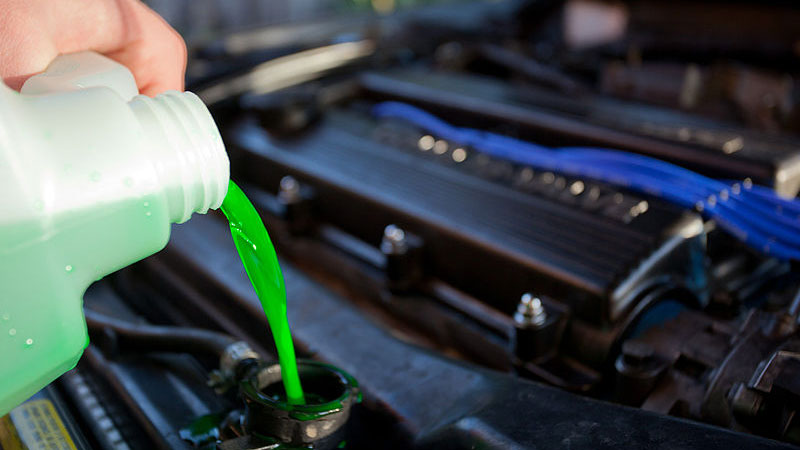What do you usually do with used antifreeze after draining, flushing, and replacing your radiator? Well, with a sweet smell, you might think this liquid is harmless. Then you decide just to pour it down the drain or into the septic system or backyard.
NO! Don’t do that. It is chemical, not water, and it’s dangerous!
Pouring it into the ground won’t make it magically go away, but it will cause adverse environmental impacts on the local ecosystem. Then, how do you properly dispose of this stuff?
See Also – How to Dispose of Old Gasoline and Used Motor Oil
Why is Antifreeze Hazardous?
Antifreeze (also called coolant) is a special lubricant that runs through your car engine. It helps prevent it from overheating at high temperatures and being cracked by freezing at low temperatures.
Antifreeze is made from ethylene glycol, propylene, or methanol. Propylene glycol is an ingredient used in cosmetics and some foods. That’s why it is harmless if used in small amounts. Whereas, ethylene glycol and methanol are very poisonous if ingested.
These chemicals have a sweet smell that is very attractive to kids and animals. Even small amounts can attack the body’s nervous system and lead to kidney failure. Ethylene glycol can cause birth defects, damage to kidneys, liver, lungs, and the brain. And in the worst situation, it can lead to death if left untreated.
Accidents from antifreeze can be prevented by keeping it out of reach of children and animals. If there is a leak or spills from your vehicle, you need to clean it up because wild animals and your pets can drink it. After flushing or changing your coolant, it’s a must to dispose of this liquid safely.
How to Dispose of Antifreeze?
When it comes to the process of antifreeze disposal, it’s important to follow the local laws and regulations. You can find the management department or organization in charge of this job.
They will manage and regulate hazardous materials like antifreeze, oils, fluids, and batteries. Hence, they will instruct you on how to do it.
Classify Types of Used Antifreeze
There are two types of used antifreeze: normally used antifreeze and tainted antifreeze.
Normal Antifreeze has bright clear colors (green, orange, blue, or pink) and smells sweet. It is obtained from normal maintenance procedures.
Tainted Antifreeze looks dirty and has a different color from the original color or smells like gas. When a vehicle is damaged, coolant can be contaminated with other oils, fluids, or gas and make it polluted. This type of antifreeze is highly hazardous compared to the normally used type.
Since they are different, they will be shipped to separate places for recycling.
Label and Store Antifreeze Containers
You can use the old antifreeze bottles to contain these liquids and make sure they are sealable. Do not mix them with anything else.
Recall what we said, both types of antifreeze will be shipped to different places, so label them to remember which one is normally used or tainted.
When you label them, carefully note their types, the date you changed your coolant, and related information (chemical, color, and brand name if you remember).
Contact Disposal Centers or Recycling Facilities
Normally Used Antifreeze
There are three common ways to contact these recycling service stations:
- Find your State’s Department of Waste Management website. They will provide a list of centers and related information for recycling or disposing of antifreeze. You can easily contact them by phone or email.
- Go to Earth 911’s Recycling Locator website, search for antifreeze and enter your zip code to find recycling centers in your area.
- Check with your Authorized landfill if they have tanks for disposing of used antifreeze.
Tainted Antifreeze
As we said earlier, this type of antifreeze cannot be recycled, and it is only accepted by hazardous waste disposal.
Ask the local or state government, mechanics, or automotive shops services for instructions if you don’t know what to do. There might be a fee for disposal if you go for the store route, but anyway it’s much cheaper than paying a fine for doing illegal things and harming our environment.
Another easy way to dispose of this type of coolant is to search on the internet. Type this phrase “hazardous chemical disposal” on Google to know if there are any hazardous chemical facilities in your area.
Note: In case you can not get to recycling facilities to dispose of coolant right away, you need to store them yourself. Keep them in a separately safe place where your kids or animals can not access them.
Transport the Antifreeze Safely to Recycling Facilities or Centers
Once you contact the service centers, it’s time to deliver these containers to them. You have two options:
1. Hire Waste Oil Service or Commercial Hauler
Call services for help can make this process easier. But people usually do this when they need to ship large amounts of used coolant. Of course, it will cost you money. You can consider doing it yourself since this can help you save a few bucks.
2. Drive it yourself
Before you ship them, make sure the containers are well-sealed. To be more careful, you can use a cable to secure them on the back seats or trunks.
As we stated before, only pure used antifreeze is recycled, polluted antifreeze must be disposed of at hazardous waste facilities. If you have these two types, you need to ship them to different places.
Note: When you reach the recycling facility, don’t forget to get a receipt showing where you disposed of the antifreeze.
How to Remove Antifreeze Spills

Preparation:
- Gloves
- Goggles
- Mask
- Absorbent material: baking soda, sand, or kitty litter
- Tissues
- Trash bags
- Detergent: soap or dish detergent
Step-by-Step Guide
The first thing to remember, keep your kids and pets away when doing this job.
Step 1: Put on protective gloves, goggles and wear a mask.
When you see a spill of coolant, immediately ventilate the area. Wear a mask to prevent inhaling the smell. Safety glasses and long sleeves can help you avoid skin contact.
Step 2: Cover the spill with absorbent material.
Absorbent materials such as sand, baking soda, or kitty litter (whatever you have) can help pick up the antifreeze.
Step 3: Cover the materials with paper towels.
Paper towels will help absorb and protect the material from escaping. Wait one-to-three hours for the antifreeze to be absorbed. Don’t let it rest for more than three hours since the spill can leave a stain.
Step 4: Wipe up the paper towels and materials.
Use dry tissues to wipe up the mess and put them into a trash bag. For the leftover antifreeze or materials, continue picking them till the area is clean. Make sure the trash is well-sealed, then throw it into the bin.
Step 5: Clean the area with soap and water.
Apply soap or dish detergent over the stain on your floor, scrub it then rinse with water. For stains that are hard to clean, pour more detergent on them, scrub them with a brush. Then flush them away with more water.
Step 6: Dry wet area in the open air.
Open all windows or doors nearby to make the floor dry quicker. In case it takes too long to be dried, layer it with some paper towels or newspapers in hours.
Worth Mentioning
The last thing we want to share with you: the laws and regulations can be different from state to state. And we cannot tell you the rules required in a specific area, but we have broken down the right ways to figure out what the rules are for you.
We are now sure that you have deep knowledge of antifreeze. It is dangerous and not on the approval list. The job of disposing of it might be difficult at first, but once you know how to do this process, it’s just a piece of cake!
- What the Letters and Numbers On an Automatic Gear Shift Mean - Sep 12, 2022
- How Long Does it Take to Change Tires? (Professional vs DIY) - Jun 8, 2022
- 2022 Ford Bronco EcoBoost Performance & Off-Roading Specs - Jun 2, 2022



